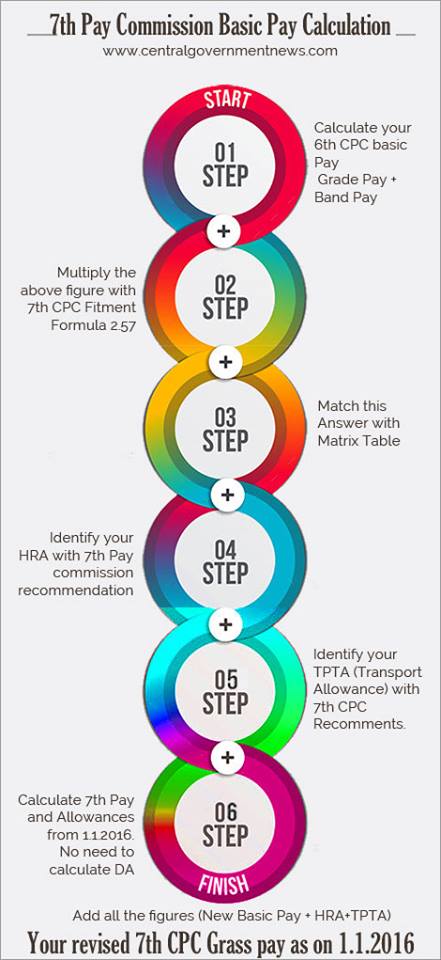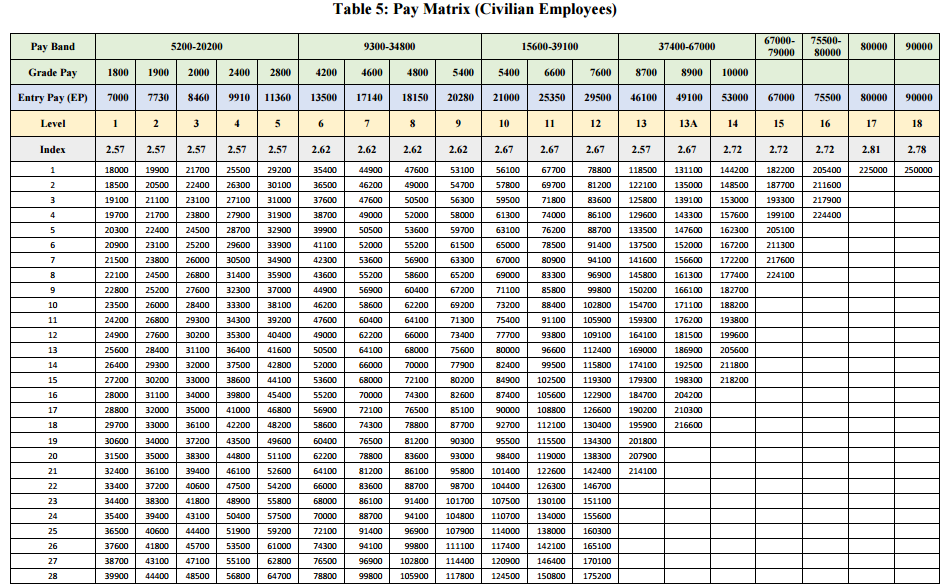Recommended Date of implementation: 01.01.2016
Minimum Pay: Based on the Aykroyd formula, the minimum pay in government is recommended to be set at Rs.18,000 per month.
Maximum Pay: Rs.2,25,000 per month for Apex Scale and
Rs.2,50,000 per month for Cabinet Secretary and others presently at the
same pay level.
Financial Implications:The total financial impact in
the FY 2016-17 is likely to be Rs.1,02,100 crore, over the expenditure
as per the ‘Business As Usual’ scenario. Of this, the increase in pay
would be Rs.39,100 crore, increase in allowances would be Rs. 29,300
crore and increase in pension would be Rs.33,700 crore.
Out of the total financial impact of Rs.1,02,100 crore, Rs.73,650
crore will be borne by the General Budget and Rs.28,450 crore by the
Railway Budget.
In percentage terms the overall increase in pay & allowances and
pensions over the ‘Business As Usual’ scenario will be 23.55 percent.
Within this, the increase in pay will be 16 percent, increase in
allowances will be 63 percent, and increase in pension would be 24
percent.
The total impact of the Commission’s recommendations are expected to
entail an increase of 0.65 percentage points in the ratio of expenditure
on (Pay+Allowances+ Pension) to GDP compared to 0.77 percent in case of
VI CPC.
New Pay Structure: Considering the issues raised regarding
the Grade Pay structure and with a view to bring in greater
transparency, the present system of pay bands and grade pay has been
dispensed with and a new pay matrix has been designed. Grade Pay has
been subsumed in the pay matrix. The status of the employee, hitherto
determined by grade pay, will now be determined by the level in the pay
matrix.
Fitment: A fitment factor of 2.57 is being proposed to be applied uniformly for all employees.
Annual Increment: The rate of annual increment is being retained at 3 percent.
Modified Assured Career Progression (MACP):Performance benchmarks for MACP have been made more stringent from “
Good” to “Very Good”.
The Commission has also proposed that annual increments not be
granted in the case of those employees who are not able to meet the
benchmark either for MACP or for a regular promotion in the first 20
years of their service.
No other changes in MACP recommended.
Military Service Pay (MSP): The Military Service
Pay, which is a compensation for the various aspects of military
service, will be admissible to the Defence forces personnel only. As
before, Military Service Pay will be payable to all ranks up to and
inclusive of Brigadiers and their equivalents. The current MSP per month
and the revised rates recommended are as follows:
Short Service Commissioned Officers: Short Service
Commissioned Officers will be allowed to exit the Armed Forces at any
point in time between 7 and 10 years of service, with a terminal
gratuity equivalent of 10.5 months of reckonable emoluments. They will
further be entitled to a fully funded one year Executive Programme or a
M.Tech. programme at a premier Institute.
Lateral Entry/Settlement: The Commission is
recommending a revised formulation for lateral entry/resettlement of
defence forces personnel which keeps in view the specific requirements
of organization to which such personnel will be absorbed. For lateral
entry into CAPFs an attractive severance package has been recommended.
Headquarters/Field Parity: Parity between field and headquarters staff recommended for similar functionaries e.g Assistants and Stenos.
Cadre Review: Systemic change in the process of Cadre Review for Group A officers recommended.
Allowances: The Commission has recommended
abolishing 52 allowances altogether. Another 36 allowances have been
abolished as separate identities, but subsumed either in an existing
allowance or in newly proposed allowances. Allowances relating to Risk
and Hardship will be governed by the proposed Risk and Hardship Matrix.
Risk and Hardship Allowance: Allowances relating to
Risk and Hardship will be governed by the newly proposed nine-cell Risk
and Hardship Matrix, with one extra cell at the top, viz., RH-Max to
include Siachen Allowance.
The current Siachen Allowance per month and the revised rates recommended are as follows:
This
would be the ceiling for risk/hardship allowances and there would be no
individual RHA with an amount higher than this allowance.
House Rent Allowance: Since the Basic Pay has been revised upwards, the Commission recommends that HRA be paid at the
rate of 24 percent, 16 percent and 8 percent of the new Basic Pay for Class X, Y and Z cities respectively.
The Commission also recommends that the rate of HRA will be revised to
27 percent, 18 percent and 9 percent respectively when DA crosses 50
percent, and further revised to 30 percent, 20 percent and 10 percent
when DA crosses 100 percent.
In the case of PBORs of Defence, CAPFs and Indian Coast Guard
compensation for housing is presently limited to the authorised married
establishment hence many users are being deprived. The HRA coverage has
now been expanded to cover all.
Any allowance not mentioned in the report shall cease to exist.
Emphasis has been placed on simplifying the process of claiming allowances.
Advances:All non-interest bearing Advances have been abolished.
Regarding interest-bearing Advances, only Personal Computer Advance
and House Building Advance (HBA) have been retained. HBA ceiling has
been increased to
Rs.25 lakhs from the present Rs.7.5 lakhs.
Central Government Employees Group Insurance Scheme (CGEGIS):
The Rates of contribution as also the insurance coverage under the
CGEGIS have remained unchanged for long. They have now been enhanced
suitably. The following rates of CGEGIS are recommended:
Medical Facilities:Introduction of a Health Insurance Scheme for Central Government employees and pensioners has been recommended.
Meanwhile, for the benefit of pensioners residing outside the CGHS
areas, CGHS should empanel those hospitals which are already empanelled
under CS (MA)/ECHS for catering to the medical requirement of these
pensioners on a cashless basis.
All postal pensioners should be covered under CGHS. All postal dispensaries should be merged with CGHS.
Pension: The Commission recommends a revised pension
formulation for civil employees including CAPF personnel as well as for
Defence personnel, who have retired before 01.01.2016. This formulation
will bring about parity between past pensioners and current retirees
for the same length of service in the pay scale at the time of
retirement.
The past pensioners shall first be fixed in the Pay Matrix being
recommended by the Commission on the basis of Pay Band and Grade Pay at
which they retired, at the minimum of the corresponding level in the pay
matrix.
This amount shall be raised to arrive at the notional pay of
retirees, by adding number of increments he/she had earned in that level
while in service at the rate of 3 percent.
In the case of defence forces personnel this amount will include Military Service Pay as admissible.
Fifty percent of the total amount so arrived at shall be the new pension.
An alternative calculation will be carried out, which will be a multiple of 2.57 times of the current basic pension.
The pensioner will get the higher of the two.
Gratuity: Enhancement in the ceiling of gratuity
from the existing Rs.10 lakh to Rs.20 lakh. The ceiling on gratuity may
be raised by 25 percent whenever DA rises by 50 percent.
Disability Pension for Armed Forces: The Commission
is recommending reverting to a slab based system for disability element,
instead of existing percentile based disability pension regime.
Ex-gratia Lump sum Compensation to Next of Kin: The
Commission is recommending the revision of rates of lump sum
compensation for next of kin (NOK) in case of death arising in various
circumstances relating to performance of duties, to be applied uniformly
for the defence forces personnel and civilians including CAPF
personnel.
Martyr Status for CAPF Personnel: The Commission is
of the view that in case of death in the line of duty, the force
personnel of CAPFs should be accorded martyr status, at par with the
defence forces personnel.
New Pension System: The Commission received many
grievances relating to NPS. It has recommended a number of steps to
improve the functioning of NPS. It has also recommended establishment of
a strong grievance redressal mechanism.
Regulatory Bodies: The Commission has recommended a
consolidated pay package of Rs.4,50,000 and Rs.4,00,000 per month for
Chairpersons and Members respectively of select Regulatory bodies. In
case of retired government servants, their pension will not be deducted
from their consolidated pay. The consolidated pay package will be raised
by 25 percent as and when Dearness Allowance goes up by 50 percent. For
Members of the remaining Regulatory bodies normal replacement pay has
been recommended.
Performance Related Pay: The Commission has
recommended introduction of the Performance Related Pay (PRP) for all
categories of Central Government employees, based on quality Results
Framework Documents, reformed Annual Performance Appraisal Reports and
some other broad Guidelines. The Commission has also recommended that
the PRP should subsume the existing Bonus schemes.
There are few recommendations of the Commission where there was no unanimity of view and these are as follows:
The Edge: An edge is presently accordeded to the
Indian Administrative Service (IAS) and the Indian Foreign Service (IFS)
at three promotion stages from Senior Time Scale (STS), to the Junior
Administrative Grade (JAG) and the NFSG. is recommended by the Chairman,
to be extended to the Indian Police Service (IPS) and Indian Forest
Service (IFoS).
hri Vivek Rae, Member is of the view that financial edge is justified
only for the IAS and IFS. Dr. Rathin Roy, Member is of the view that
the financial edge accorded to the IAS and IFS should be removed.
Empanelment: The Chairman and Dr. Rathin Roy,
Member, recommend that All India Service officers and Central Services
Group A officers who have completed 17 years of service should be
eligible for empanelment under the Central Staffing Scheme and there
should not be “two year edge”, vis-à-vis the IAS. Shri Vivek Rae,
Member, has not agreed with this view and has recommended review of the
Central Staffing Scheme guidelines.
Non Functional Upgradation for Organised Group ‘A’ Services: The
Chairman is of the view that NFU availed by all the organised Group `A’
Services should be allowed to continue and be extended to all officers
in the CAPFs, Indian Coast Guard and the Defence forces. NFU should
henceforth be based on the respective residency periods in the preceding
substantive grade. Shri Vivek Rae, Member and Dr. Rathin Roy, Member,
have favoured abolition of NFU at SAG and HAG level.
Superannuation:
Chairman and Dr. Rathin Roy, Member, recommend the age of superannuation for all CAPF personnel should be 60 years uniformly. Shri Vivek Rae, Member, has not agreed with this recommendation and has endorsed the stand of the Ministry of Home Affairs.
The full report is available in the website, http://7cpc.india.gov.in.
PIB
 7th Pay Commission Basic Pay Calculation Method in brief with illustration
7th Pay Commission Basic Pay Calculation Method in brief with illustration



















